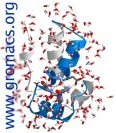

|
gmx editconf |
|
| Main Table of Contents | VERSION 5.0.1 | |
gmx editconf [-f [<.gro/.g96/...>]] [-n [<.ndx>]] [-o [<.gro/.g96/...>]]
[-mead [<.pqr>]] [-bf [<.dat>]] [-nice ] [-[no]w]
[-[no]ndef] [-bt ] [-box ] [-angles ]
[-d ] [-[no]c] [-center ] [-aligncenter ]
[-align ] [-translate ] [-rotate ]
[-[no]princ] [-scale ] [-density ] [-[no]pbc]
[-resnr ] [-[no]grasp] [-rvdw ] [-[no]sig56]
[-[no]vdwread] [-[no]atom] [-[no]legend] [-label ]
[-[no]conect]
The box can be modified with options -box, -d and -angles. Both -box and -d will center the system in the box, unless -noc is used.
Option -bt determines the box type: triclinic is a triclinic box, cubic is a rectangular box with all sides equal dodecahedron represents a rhombic dodecahedron and octahedron is a truncated octahedron. The last two are special cases of a triclinic box. The length of the three box vectors of the truncated octahedron is the shortest distance between two opposite hexagons. Relative to a cubic box with some periodic image distance, the volume of a dodecahedron with this same periodic distance is 0.71 times that of the cube, and that of a truncated octahedron is 0.77 times.
Option -box requires only one value for a cubic, rhombic dodecahedral, or truncated octahedral box.
With -d and a triclinic box the size of the system in the
Option -angles is only meaningful with option -box and a triclinic box and cannot be used with option -d.
When -n or -ndef is set, a group can be selected for calculating the size and the geometric center, otherwise the whole system is used.
-rotate rotates the coordinates and velocities.
-princ aligns the principal axes of the system along the coordinate axes, with the longest axis aligned with the
Scaling is applied before any of the other operations are performed. Boxes and coordinates can be scaled to give a certain density (option -density). Note that this may be inaccurate in case a .gro file is given as input. A special feature of the scaling option is that when the factor -1 is given in one dimension, one obtains a mirror image, mirrored in one of the planes. When one uses -1 in three dimensions, a point-mirror image is obtained.
Groups are selected after all operations have been applied.
Periodicity can be removed in a crude manner. It is important that the box vectors at the bottom of your input file are correct when the periodicity is to be removed.
When writing .pdb files, B-factors can be added with the -bf option. B-factors are read from a file with with following format: first line states number of entries in the file, next lines state an index followed by a B-factor. The B-factors will be attached per residue unless an index is larger than the number of residues or unless the -atom option is set. Obviously, any type of numeric data can be added instead of B-factors. -legend will produce a row of CA atoms with B-factors ranging from the minimum to the maximum value found, effectively making a legend for viewing.
With the option -mead a special .pdb (.pqr) file for the MEAD electrostatics program (Poisson-Boltzmann solver) can be made. A further prerequisite is that the input file is a run input file. The B-factor field is then filled with the Van der Waals radius of the atoms while the occupancy field will hold the charge.
The option -grasp is similar, but it puts the charges in the B-factor and the radius in the occupancy.
Option -align allows alignment of the principal axis of a specified group against the given vector, with an optional center of rotation specified by -aligncenter.
Finally, with option -label, editconf can add a chain identifier to a .pdb file, which can be useful for analysis with e.g. Rasmol.
To convert a truncated octrahedron file produced by a package which uses a cubic box with the corners cut off (such as GROMOS), use:
gmx editconf -f in -rotate 0 45 35.264 -bt o -box veclen -o out
where veclen is the size of the cubic box times sqrt(3)/2.